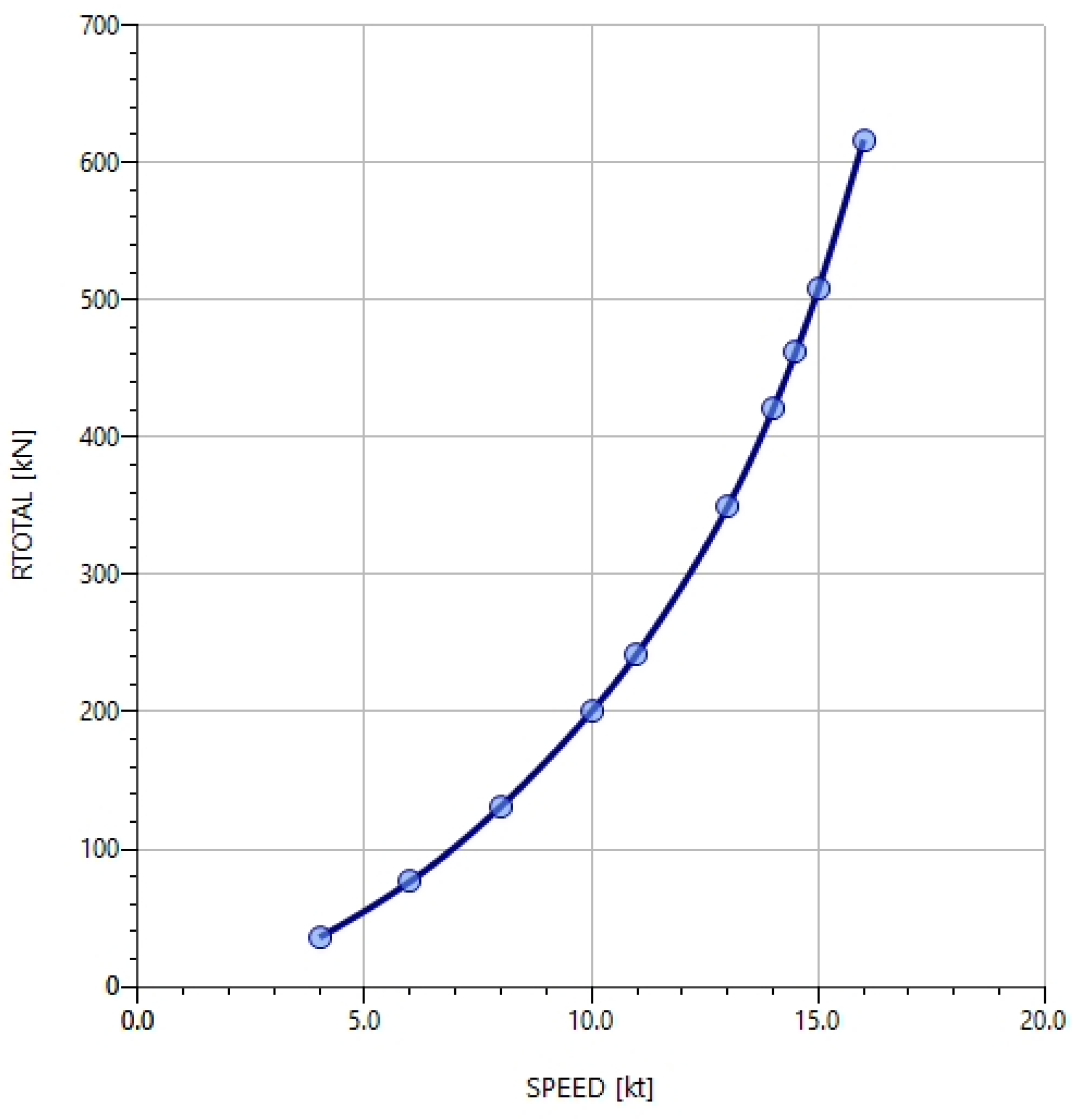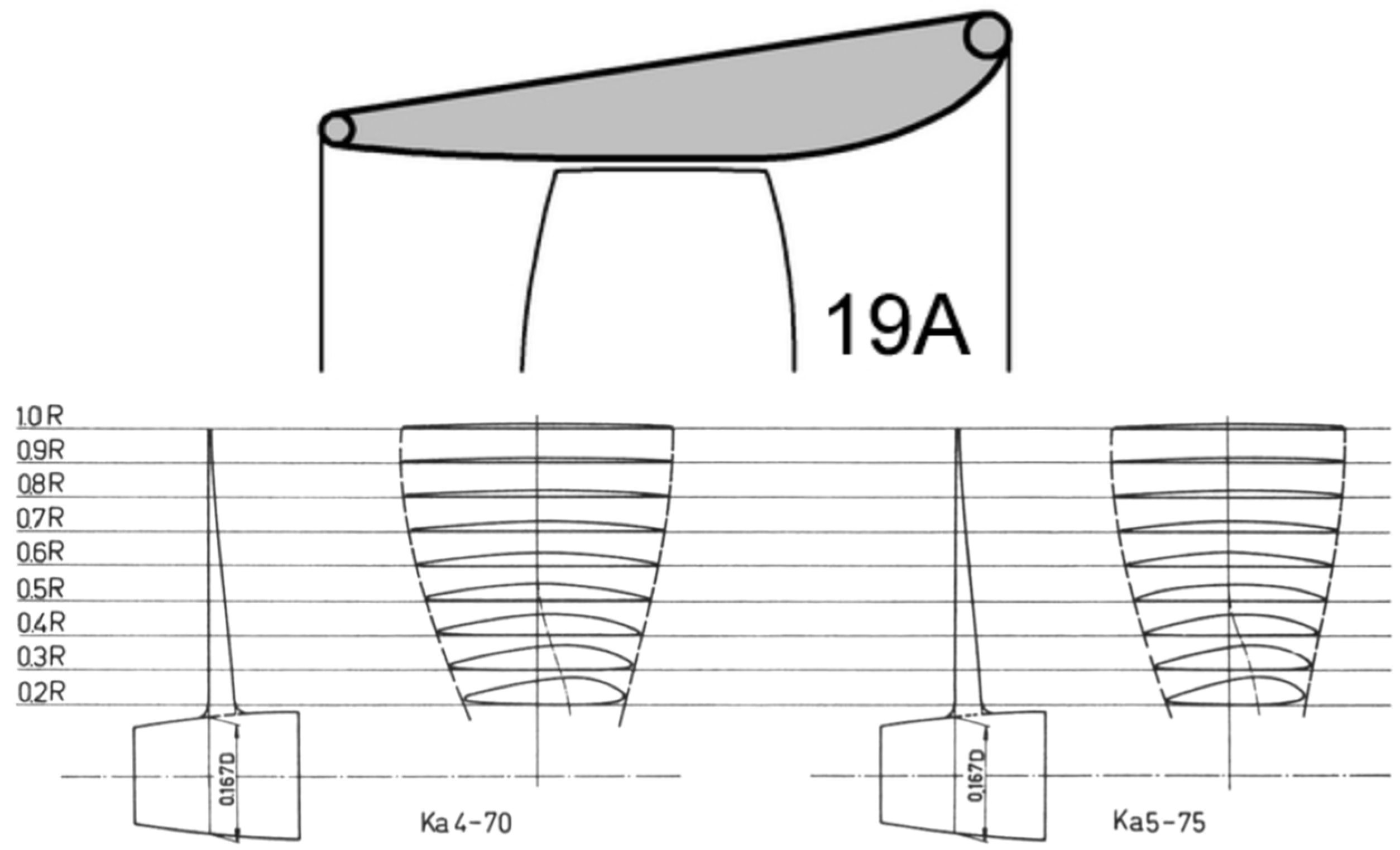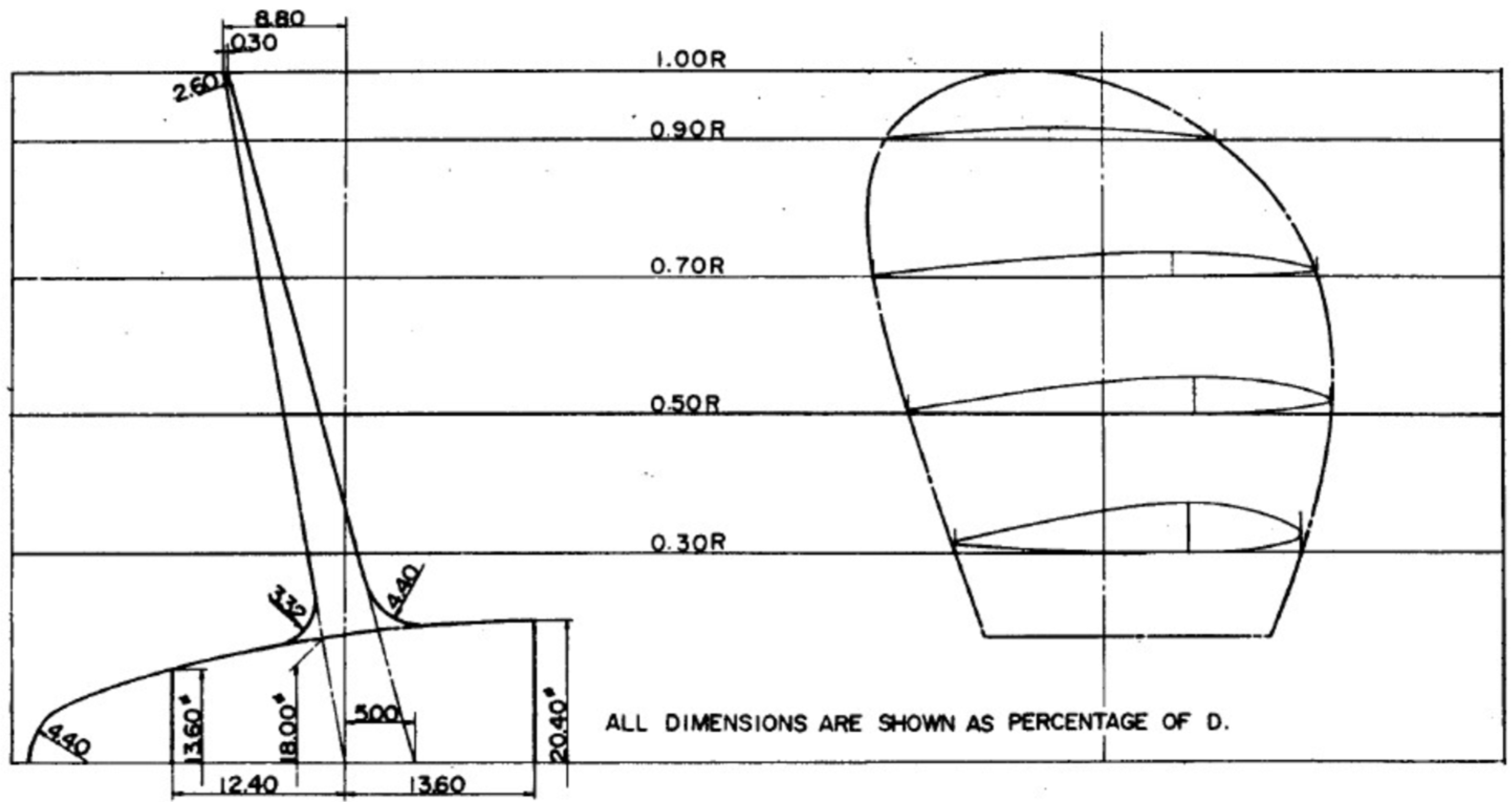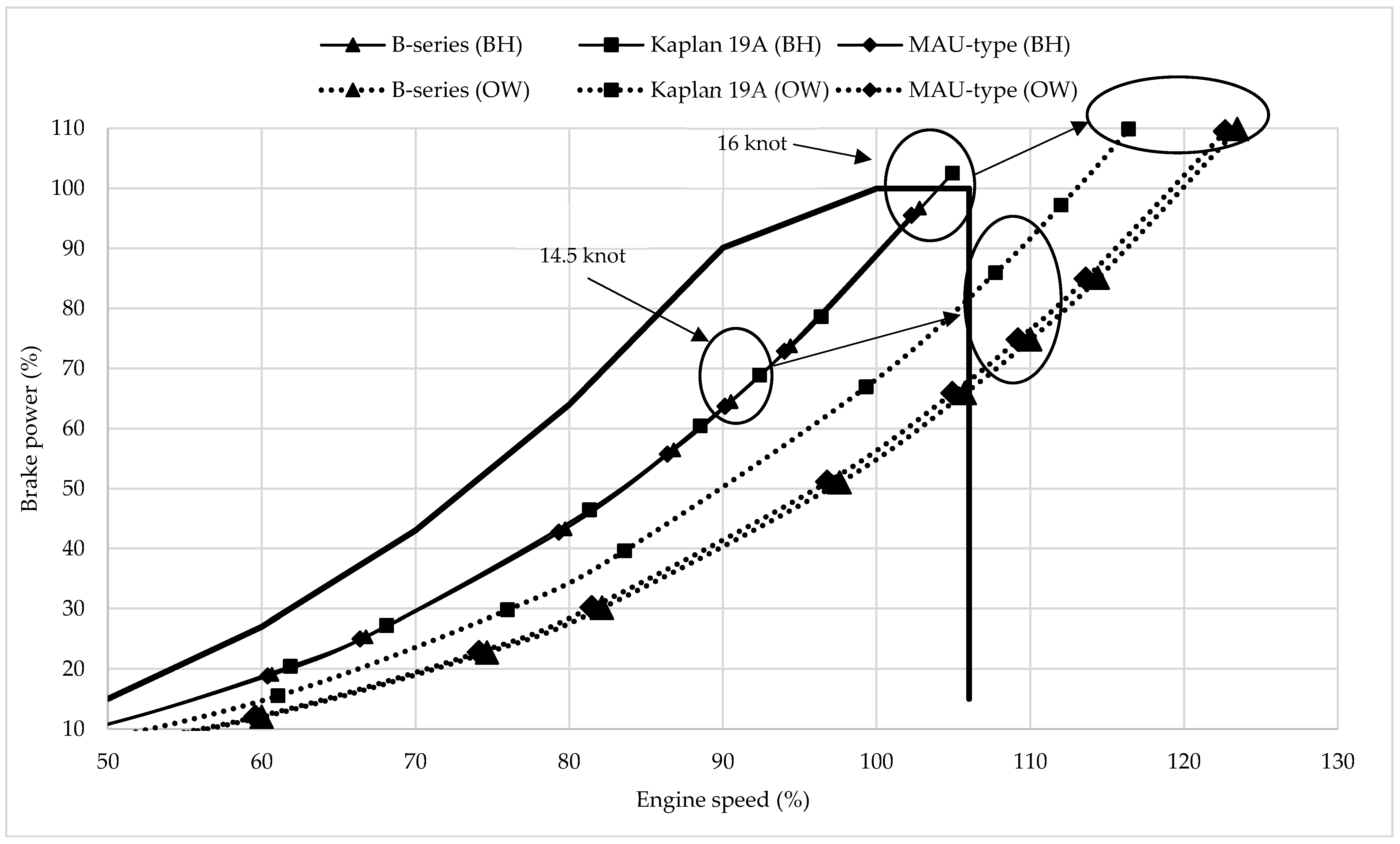Design of Propeller Series Optimizing Fuel Consumption and Propeller Efficiency
Abstract
:1. Introduction
2. Main Specifications of Bulk Carrier
3. Numerical Model
4. Propeller Performance
5. Optimization Model
6. Results
7. Conclusions
- The presented model can optimize the propeller performance in an adequate simulation time.
- The configurations of the optimizer are kept the same for all simulated cases to present a clear comparison between the different cases.
- The optimum propeller characteristics, propeller operation, and gearbox ratio are selected according to the input boundary limits as well as the defined constraints, where the propeller complies with the limitations of cavitation and noise.
- The MAU type shows the most efficient propeller in terms of propeller efficiency and fuel consumption, followed by the Wagengein B-series and Kaplan 19A propellers.
- When the propeller is selected at a lower brake power, a higher fuel reduction is achieved.
- The hull–propulsor interaction significantly changes the propeller performance, and it must be considered for realistic design.
- The model can be adapted to further simulate any type of propeller, while the objectives of the study can also be adapted according to specific needs.
Author Contributions
Funding
Institutional Review Board Statement
Informed Consent Statement
Data Availability Statement
Conflicts of Interest
Abbreviations
| ηo | Propeller efficiency |
| ηRR | Relative rotative efficiency |
| BEM | Boundary element method |
| BH | Behind hull |
| BSFC | Brake specific fuel consumption |
| c(x) | Inequality constraints |
| ceq(x) | Equality constraints |
| CO2 | Carbon dioxide |
| D | Diameter |
| EAR | Expanded area ratio |
| EEDI | Energy efficiency design index |
| EEXI | Energy efficiency of existing ship index |
| f(x) | Objective function |
| FC | Fuel consumption |
| FEM | Finite element method |
| FPP | Fixed pitch propeller |
| g(x) | Static penalty function |
| GA | Genetic algorithm |
| GBR | Gearbox ratio |
| J | Advance coefficient |
| j | Number of constraints |
| KQ | Torque coefficient |
| KT | Thrust coefficient |
| lb | Lower bounds |
| n | Propeller speed |
| N | Propeller speed |
| NOx | Nitrogen dioxides |
| NSGA-II | Non-dominated sorting algorithm II |
| OW | Open water |
| P/D | Pitch diameter ratio |
| Q | Torque |
| R | Penalty function |
| RT | Total ship resistance |
| SOx | Sulphur dioxides |
| SQP | Sequential quadratic programming |
| SUMT | Sequential unconstrained optimization technique |
| T | Thrust |
| t | Thrust deduction fraction |
| ub | Upper bounds |
| VA | Advance speed |
| VS | Ship speed |
| w | Taylor wake fraction |
| w1, w2 | Weights |
| x | Number of variables |
| Z | Number of blades |
| ρ | Density |
References
- Carlton, J. Marine Propellers and Propulsion, 2nd ed.; Butterworth-Heinemann: Oxford, UK, 2012. [Google Scholar]
- Moreira, L.; Vettor, R.; Guedes Soares, C. Neural Network Approach for Predicting Ship Speed and Fuel Consumption. J. Mar. Sci. Eng. 2021, 9, 119. [Google Scholar] [CrossRef]
- DNV-GL. EEXI—Energy Efficiency Existing Ship Index. Available online: https://www.dnvgl.com/maritime/insights/topics/eexi/calculation.html (accessed on 1 December 2020).
- Wärtsilä. Propellers Efficiency and Manoeuvrability Improvements. Available online: https://www.wartsila.com/marine/build/propulsors-and-gears/propellers (accessed on 1 July 2021).
- MAN Energy Solutions. Propulsion: MAN Alpha Propeller & Aft Ship Solutions. Available online: https://www.man-es.com/marine/products/propeller-aft-ship (accessed on 1 July 2021).
- Taskar, B.; Yum, K.K.; Steen, S.; Pedersen, E. The effect of waves on engine-propeller dynamics and propulsion performance of ships. Ocean Eng. 2016, 122, 262–277. [Google Scholar] [CrossRef] [Green Version]
- Tadros, M.; Ventura, M.; Guedes Soares, C. Optimization scheme for the selection of the propeller in ship concept design. In Progress in Maritime Technology and Engineering; Guedes Soares, C., Santos, T.A., Eds.; Taylor & Francis Group: London, UK, 2018; pp. 233–239. [Google Scholar]
- Gaggero, S.; Tani, G.; Villa, D.; Viviani, M.; Ausonio, P.; Travi, P.; Bizzarri, G.; Serra, F. Efficient and multi-objective cavitating propeller optimization: An application to a high-speed craft. Appl. Ocean. Res. 2017, 64, 31–57. [Google Scholar] [CrossRef]
- Tadros, M.; Ventura, M.; Guedes Soares, C. A nonlinear optimization tool to simulate a marine propulsion system for ship conceptual design. Ocean Eng. 2020, 210, 1–15. [Google Scholar] [CrossRef]
- Harsha Vardhan, D.; Ramesh, A.; Chandra Mohan Reddy, B. A Review On Materials Used For Marine Propellers. Mater. Today Proc. 2019, 18, 4482–4490. [Google Scholar] [CrossRef]
- Vettor, R.; Guedes Soares, C. Development of a ship weather routing system. Ocean Eng. 2016, 123, 1–14. [Google Scholar] [CrossRef]
- van Lammeren, W.P.A.; van Manen, J.D.; Oosterveld, M.W.C. The Wageningen B-screw series. Trans. SNAME 1969, 77, 269–317. [Google Scholar]
- Oosterveld, M.; Van Oossanen, P. Further computer-analyzed data of the Wageningen B-screw series. Int. Shipbuild. Prog. 1975, 22, 251–262. [Google Scholar] [CrossRef] [Green Version]
- HydroComp. NavCad: Reliable and Confident Performance Prediction. Available online: https://wwW hydrocompinc.com/solutions/navcad/ (accessed on 30 January 2019).
- Hillier, F.S.; Lieberman, G.J. Introduction to Operations Research; McGraw-Hill: New York, NY, USA, 1980. [Google Scholar]
- Radojčić, D. Optimal Preliminary Propeller Design Using Nonlinear Constrained Mathematical Programming Technique; University of Southampton: Southampton, UK, 1985; Volume 21, pp. 1–22. [Google Scholar]
- Suen, J.-b.; Kouh, J.-s. Genetic algorithms for optimal series propeller design. In Proceedings of the Third International Conference on Marine Technology; WIT press: Szczecin, Poland, 1999; pp. 1–10. [Google Scholar]
- Benini, E. Multiobjective design optimization of B-screw series propellers using evolutionary algorithms. Mar. Technol. 2003, 40, 229–238. [Google Scholar]
- Lee, C.-S.; Choi, Y.-D.; Ahn, B.-K.; Shin, M.-S.; Jang, H.-G. Performance optimization of marine propellers. Int. J. Nav. Archit. Ocean. Eng. 2010, 2, 211–216. [Google Scholar] [CrossRef] [Green Version]
- Gaafary, M.M.; El-Kilani, H.S.; Moustafa, M.M. Optimum design of B-series marine propellers. Alex. Eng. J. 2011, 50, 13–18. [Google Scholar] [CrossRef] [Green Version]
- Vesting, F.; Bensow, R. Propeller Optimisation Considering Sheet Cavitation and Hull Interaction. In Proceedings of the Second International Symposium on Marine Propulsors (SMP’11), Hamburg, Germany, 15–17 June 2011. [Google Scholar]
- Xie, G. Optimal Preliminary Propeller Design Based on Multi-objective Optimization Approach. Procedia Eng. 2011, 16, 278–283. [Google Scholar] [CrossRef] [Green Version]
- Mirjalili, S.; Lewis, A.; Mirjalili, S.A.M. Multi-objective Optimisation of Marine Propellers. Procedia Comput. Sci. 2015, 51, 2247–2256. [Google Scholar] [CrossRef] [Green Version]
- Epps, B.P.; Stanway, M.J.; Kimball, R.W. OpenProp: An Open-source Design Tool for Propellers and Turbines. In Proceedings of the SNAME Propellers and Shafting Symposium, Williamsburg, VA, USA, 15–16 September 2009. [Google Scholar]
- Khan, A.M. Flexible Composite Propeller Design Using Constrained Optimization Techniques. Ph.D. Thesis, Iowa State University, Ames, IA, USA, 1997. [Google Scholar]
- Karim, M.; Ikehata, M. A genetic algorithm (GA)-based optimization technique for the design of marine propellers. In Proceedings of the Propeller/Shafting 2000 Symposium, SNAME, Virginia Beach, VA, USA, 20–21 September 2000. [Google Scholar]
- Pluciński, M.M.; Young, Y.L.; Liu, Z. Optimization of a self-twisting composite marine propeller using genetic algorithms. In Proceedings of the 16th International Conference on Composite Materials, Kyoto, Japan, 8–13 July 2007. [Google Scholar]
- Tadros, M.; Ventura, M.; Guedes Soares, C. Optimum design of a container ship’s propeller from Wageningen B-series at the minimum BSFC. In Sustainable Development and Innovations in Marine Technologies; Georgiev, P., Guedes Soares, C., Eds.; Taylor & Francis Group: London, UK, 2020; pp. 269–274. [Google Scholar]
- DNV. Class Guideline: Calculation of Marine Propellers; DNV: Bærum, Norway, 2021. [Google Scholar]
- Chen, J.-H.; Shih, Y.-S. Basic design of a series propeller with vibration consideration by genetic algorithm. J. Mar. Sci. Technol. 2007, 12, 119–129. [Google Scholar] [CrossRef]
- Tadros, M.; Vettor, R.; Ventura, M.; Guedes Soares, C. Coupled Engine-Propeller Selection Procedure to Minimize Fuel Consumption at a Specified Speed. J. Mar. Sci. Eng. 2021, 9, 59. [Google Scholar] [CrossRef]
- Michalsk, J.P. A method for selection of parameters of ship propulsion system fitted with compromise screw propeller. Pol. Marit. Res. 2007, 14, 3–6. [Google Scholar] [CrossRef] [Green Version]
- Nelson, M.; Temple, D.W.; Hwang, J.T.; Young, Y.L.; Martins, J.R.R.A.; Collette, M. Simultaneous optimization of propeller–hull systems to minimize lifetime fuel consumption. Appl. Ocean Res. 2013, 43, 46–52. [Google Scholar] [CrossRef]
- Tadros, M. Optimization Procedures to Minimize the Fuel Consumption of Marine Diesel Propulsion Systems. Ph.D. Thesis, University of Lisbon, Lisbon, Portugal, 2020. [Google Scholar]
- Oosterveld, M.W.C. Wake Adapted Ducted Propellers. Ph.D. Thesis, Delft University of Technology, Delft, The Netherlands, 1970. [Google Scholar]
- Suh, J.C.; Lee, C.S. Polynomial Representation for MAU-Propeller Open Water Characteristics. Korean Inst. Mach. Mater. 1984, 11, 95–101. [Google Scholar]
- Equasis. The World Merchant Fleet in 2019. Available online: https://www.equasis.org/EquasisWeb/restricted/About?fs=HomePage (accessed on 5 March 2020).
- MAN Diesel & Turbo. 32/44CR Project Guide—Marine. Available online: https://www.engines.man.eu (accessed on 31 August 2017).
- The MathWorks Inc. Constrained Nonlinear Optimization Algorithms. Available online: https://www.mathworks.com/help/optim/ug/constrained-nonlinear-optimization-algorithms.html (accessed on 3 February 2018).
- Holtrop, J.; Mennen, G.G.J. An approximate power prediction method. Int. Shipbuild. Prog. 1982, 29, 166–170. [Google Scholar] [CrossRef]
- Holtrop, J. A statistical re-analysis of resistance and propulsion data. Int. Shipbuild. Prog. 1984, 31, 272–276. [Google Scholar]
- ITTC. Uncertainty Analysis, Example for Resistance Test. In Proceedings of the 23th ITTC, Venice, Italy, 8–14 September 2002. [Google Scholar]
- Tadros, M.; Ventura, M.; Guedes Soares, C. Optimization procedure to minimize fuel consumption of a four-stroke marine turbocharged diesel engine. Energy 2019, 168, 897–908. [Google Scholar] [CrossRef]
- Tadros, M.; Ventura, M.; Guedes Soares, C. Simulation of the performance of marine genset based on double-Wiebe function. In Sustainable Development and Innovations in Marine Technologies; Georgiev, P., Guedes Soares, C., Eds.; Taylor & Francis Group: London, UK, 2020; pp. 292–299. [Google Scholar]
- Tadros, M.; Ventura, M.; Guedes Soares, C. Optimization of the performance of marine diesel engines to minimize the formation of SOx emissions. J. Mar. Sci. Appl. 2020, 19, 473–484. [Google Scholar] [CrossRef]
- Tadros, M.; Ventura, M.; Guedes Soares, C. Surrogate models of the performance and exhaust emissions of marine diesel engines for ship conceptual design. In Maritime Transportation and Harvesting of Sea Resources; Guedes Soares, C., Teixeira, A.P., Eds.; Taylor & Francis Group: London, UK, 2018; pp. 105–112. [Google Scholar]
- Vettor, R.; Tadros, M.; Ventura, M.; Guedes Soares, C. Route planning of a fishing vessel in coastal waters with fuel consumption restraint. In Maritime Technology and Engineering 3; Guedes Soares, C., Santos, T.A., Eds.; Taylor & Francis Group: London, UK, 2016; pp. 167–173. [Google Scholar]
- Laurens, J.-M.; Leroux, J.-B.; Coache, S. Design and retrofit of the propulsion of trawlers to improve their efficiency. In Developments in Maritime Transportation and Exploitation of Sea Resources; Guedes Soares, C., López, P., Eds.; Taylor & Francis Group: London, UK, 2013; pp. 1075–1084. [Google Scholar]
- King-Sea Marine. Marine Propellers. Available online: http://www.kingseamarine.com/5_blade_mau_type_ship_propeller_1306.html (accessed on 21 September 2021).
- Burrill, L.C.; Emerson, A. Propeller cavitation: Further tests on 16in. propeller models in the King’s College cavitation tunnel. Int. Shipbuild. Prog. 1963, 10, 119–131. [Google Scholar] [CrossRef]
- Blount, D.L.; Fox, D.L. Design Considerations for Propellers in a Cavitating Environment. Mar. Technol. 1978, 15, 144–178. [Google Scholar]





| Item | Unit | Value |
|---|---|---|
| Length waterline | m | 154 |
| Breadth | m | 23.11 |
| Draft | m | 10 |
| Displacement | tonne | 27,690 |
| Service speed | knot | 14.5 |
| Maximum speed | knot | 16 |
| Number of propellers | - | 1 |
| Type of propellers | - | FPP |
| Rated power | kW | 7140 |
| Item | Unit | Value |
|---|---|---|
| Engine builder | - | MAN Energy Solutions |
| Brand name | - | MAN |
| Bore | mm | 320 |
| Stroke | mm | 440 |
| Displacement | liter | 4954 |
| Number of cylinders | - | 14 |
| Rated speed | rpm | 750 |
| Rated power | kW | 7140 |
| Parameter | Wagengein B-Series | Kaplan 19A | MAU |
|---|---|---|---|
| Number of blades | 3–7 | 3–5 | 3–6 |
| Blade area ratio | 0.35–0.80 for 3 blades 0.40–1.00 for 4 blades 0.45–1.05 for 5 blades 0.50–0.95 for 6 blades 0.55–0.85 for 7 blades | 0.65 for 3 blades 0.55–0.7 for 4 blades 0.65–0.95 for 5 blades | 0.35–0.50 for 3 blades 0.40–0.70 for 4 blades 0.50–0.80 for 5 blades 0.70–0.85 for 6 blades |
| Pitch/Diameter ratio | 0.5–1.4 | 0.5–1.4 | 0.5–1.2 |
| Advance coefficient | 0.05–1.5 | 0.05–1.5 | 0.05–1.5 |
| Parameters | Unit | Behind Hull | Open Water | Behind Hull | Open Water | Behind Hull | Open Water | |
|---|---|---|---|---|---|---|---|---|
| Propeller Type | Wageningen B-Series | Kaplan 19A | MAU | |||||
| Propeller characteristics | D | [m] | 6 | 5.11 | 6 | |||
| EAR | [-] | 0.71 | 0.75 | 0.8 | ||||
| P | [m] | 4.45 | 5.188 | 4.77 | ||||
| P/D | [-] | 0.74 | 1.01 | 0.79 | ||||
| Speed | [RPM] | 98 | 119 | 107 | 129 | 90 | 109 | |
| Thrust | [kN] | 569.88 | 461.81 | 569.88 | 461.81 | 569.88 | 461.81 | |
| Torque | [kN m] | 435.1 | 411.8 | 425.2 | 491.5 | 464.7 | 448.4 | |
| ηo | [%] | 0.59 | 0.6713 | 0.55 | 0.5169 | 0.6 | 0.6718 | |
| J | [-] | 0.474 | 0.6267 | 0.51 | 0.6762 | 0.5153 | 0.683 | |
| KT | [-] | 0.1608 | 0.0883 | 0.2565 | 0.1416 | 0.1901 | 0.1048 | |
| KQ | [-] | 0.02047 | 0.0131 | 0.0374 | 0.02947 | 0.02584 | 0.01696 | |
| w | [-] | 0.377 | 0 | 0.377 | 0 | 0.377 | 0 | |
| t | [-] | 0.189 | 0 | 0.189 | 0 | 0.189 | 0 | |
| Cavitation | Tip Speed | [m/s] | 30.77 | 37.39 | 28.6 | 34.66 | 28.3 | 34.31 |
| EARmin | [-] | 0.46 | 0.415 | 0.48 | 0.488 | 0.46 | 0.415 | |
| Average loading pressure | [kPa] | 28.4 | 23.01 | 29.19 | 29.86 | 25.23 | 20.44 | |
| Back Cavitation | [%] | 2 | 2 | 2 | 2 | 2 | 2 | |
| Gearbox characteristics | GBR | [-] | 6.93 | 6.49 | 7.50 | |||
| Engine characteristics | Speed | [RPM] | 679 | 825 | 693 | 840 | 676 | 819 |
| Brake Power | [kW] | 4602.4 | 5344.2 | 4918.5 | 6940.2 | 4545 | 5339.9 | |
| Loading ratio | [%] | 64.5 | 74.8 | 68.9 | 97.2 | 63.7 | 74.8 | |
| BSFC | [g/kW h] | 187 | 0 | 192 | 0 | 186 | 0 | |
| Fuel consumption | [L/nm] | 71.13 | 0 | 78.15 | 0 | 70.11 | 0 | |
| Exhaust emissions | CO2 | [g/kW h] | 598.4 | 0 | 614.4 | 0 | 595.2 | 0 |
| NOx | [g/kW h] | 7.11 | 0 | 7.61 | 0 | 6.91 | 0 | |
| SOx | [g/kW h] | 9.35 | 0 | 9.6 | 0 | 9.3 | 0 | |
| Simulation time | [s] | 2239 | - | 1125 | - | 5628 | - | |
Publisher’s Note: MDPI stays neutral with regard to jurisdictional claims in published maps and institutional affiliations. |
© 2021 by the authors. Licensee MDPI, Basel, Switzerland. This article is an open access article distributed under the terms and conditions of the Creative Commons Attribution (CC BY) license (https://creativecommons.org/licenses/by/4.0/).
Share and Cite
Tadros, M.; Ventura, M.; Guedes Soares, C. Design of Propeller Series Optimizing Fuel Consumption and Propeller Efficiency. J. Mar. Sci. Eng. 2021, 9, 1226. https://doi.org/10.3390/jmse9111226
Tadros M, Ventura M, Guedes Soares C. Design of Propeller Series Optimizing Fuel Consumption and Propeller Efficiency. Journal of Marine Science and Engineering. 2021; 9(11):1226. https://doi.org/10.3390/jmse9111226
Chicago/Turabian StyleTadros, Mina, Manuel Ventura, and Carlos Guedes Soares. 2021. "Design of Propeller Series Optimizing Fuel Consumption and Propeller Efficiency" Journal of Marine Science and Engineering 9, no. 11: 1226. https://doi.org/10.3390/jmse9111226
APA StyleTadros, M., Ventura, M., & Guedes Soares, C. (2021). Design of Propeller Series Optimizing Fuel Consumption and Propeller Efficiency. Journal of Marine Science and Engineering, 9(11), 1226. https://doi.org/10.3390/jmse9111226








